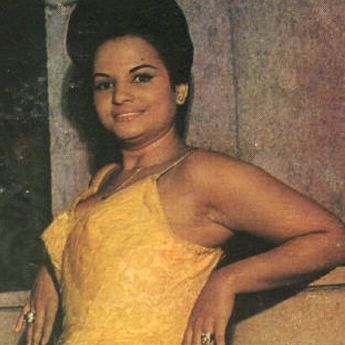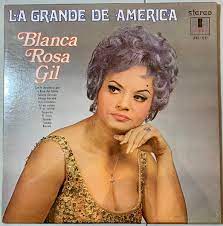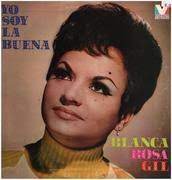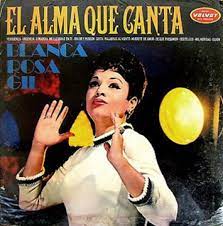BLANCA ROSA GIL, VIDA Y LEGADO MUSICAL DE “LA MUÑEQUITA QUE CANTA”. VÍDEOS.
¿Quién es Blanca Rosa Gil?
Blanca Rosa Gil también llamada “La Muñequita Que Canta”, es una famosa cantante de boleros que nació el 26 de agosto de 1937 en Perico, provincia de Matanzas, Cuba. Es una cubana que vive en Puerto Rico desde hace más de cuatro décadas. Fue una de las cantantes latinoamericanas más exitosas durante las décadas de 1960 y 1970, versionada por el sello Velvet.
Siendo aún una niña, fue llevado a Venezuela en compañía de una familia de grandes recursos económicos que tenía estrechas relaciones con el mundo artístico, o intereses en este medio.
Es así como en una ocasión, mientras se encontraba en un evento infantil, alguien la escuchó cantar y quedó prendado de lo que producían sus notas musicales, por lo que trató de hacer los arreglos necesarios con quienes la representaban desde que era menor de edad, la autorización de sus representantes era necesaria para cualquier tipo de acuerdo que la involucrara.
VIDEOS- Blanca Rosa Gil en “Yo Soy la Buena”…
CARRERA ARTISTICA
Esta gran dama de la canción es descubierta en Caracas y es contratada para cantar precisamente en La Habana, Cuba, a la temprana edad de aproximadamente 18 años. El primer disco de Blanca Rosa Gil ‘Sombras’ se grabó en Venezuela en 1957.
Así comenzó prácticamente la vida artística de la gran Blanca Rosa Gil. Cuando empezó a trabajar se hizo tan popular que fue solicitada por los grandes cabarets, la radio y la incipiente televisión, donde sus presentaciones fueron muy exitosas, lo que hizo que su fama trascendiera y comenzara, no sólo a codearse con los mejores artistas cubanos sino ser catalogado como uno de los mejores cantantes en el campo.
En 1959 graba el LP “Sombras” y el sencillo “Cristal” al año siguiente (1960). En 1961 ya estaba en México. En 1966 grabó el bolero “Hambre”, del mexicano Rosendo Montiel Álvarez, que permaneció en las listas de popularidad durante más de un año, suponiendo el mayor éxito de su carrera.
Hacia el año 1980, se alejó de los escenarios tras abrazar la “fe cristiana”. En 2003 volvió con una nueva producción y con un estilo totalmente diferente al que la conocía y por el que se había hecho famosa.
“La Dueña y Señora del Bolero”, como también es conocida Blanca Rosa Gil, es una de las grandes intérpretes del bolero que plasmó toda una época de canciones románticas con esas famosas composiciones como “Hambre”, “Cristal”, “Tú me hizo mujer”, “Besos de fuego” y “Besos de bruja”, por su voz se convirtió en un éxito, caracterizándose, como ninguna otra cantante, por la forma en que se expresaba con sus manos, las cuales convertía en un arte adicional.
El tiempo transcurrido no ha afectado a su voz, que se proyecta con la claridad, la potencia y el temperamento que la convirtieron en una estrella internacional en los albores de los años sesenta. Sobre todo, presentando un repertorio en el que atacaba con fiereza a los hombres… aunque no a un nivel tan exagerado como el que hoy utiliza la mexicana Paquita la del Barrio.
“Ayer y Hoy” contiene 16 selecciones, cinco de ellas nuevas versiones de los éxitos que la consagraron: “Cristal” (de Marianito Mores); “¿De qué se jactan?” (por Homero Aguilar Cabrera); “Hombre malo” (de L. Mendoza); “Tú fuiste mía primero” (de Luis Kalaff) y “Mal pago” (de Héctor Flores Osuna)… ¡a ritmo de salsa! El resto del contenido es el siguiente: “Ama”, en tiempo de samba (de Luis Demetrio); “Me queda la experiencia”, reggae-conga (de Concha Valdés Miranda); “La vida es un largo camino”, evangelio (de René Touzet); “Me hiciste mujer”, bolero ranchero (de Ivette Marchand); “Estoy enamorado” y “¿Qué has hecho conmigo?” (de Antonio Figueroa Carrillo, su esposo); (de su propia autoría) y, por la firma de Juan “Chino” Pacheco y Jaime Ortiz Tapia -dueños del sello JT Records- la guajira “Tierra mía”, la balada “Te soñé libre” y la salsa “La azúcar de Celia”, obviamente dedicada a la irrepetible Celia Cruz.
Se dice que se debió a que abrazó la religión o la fe cristiana, a la que dedicó todo su tiempo y se convirtió en su más fiel catequizada.
Regresó en 2003 con una nueva producción “Yo Soy La Buena” y con un estilo totalmente diferente al que la conocía y por el que se había hecho famosa. Luego sus discos Triunfadora de Cuba (2008), Ayer y Hoy Con Los Montemar (2007) Blanca Rosa Gil y Los Montemar, 40 Anos 40 Exitos (Fecha Desconocida), No Soy Tu Esclava (2006), Las Voces Del Siglo (2006 ), Los Años de Oro / Besos Brujos (2006), Besos Brujos (2005).
La música boleristica de Blanca Rosa Gil ha experimentado un renacimiento en los últimos años debido a la reedición de sus discos discográficos en disco compacto y MP3, y ocasionalmente regresa a los escenarios para interpretar sus clásicos del bolero cubano.
En 2013, Gil apareció en vivo en un concierto en el Auditorio de Miami-Dade en Miami, Florida.
Lista parcial de discos grabados por Blanca Rosa Gil
La dueña y la señora del bolero (2000)
Antología Cuba/Blanca Rosa Gil (1999)
Besos de juegos (1999)
Tu Me Hiciste Mujer (1998)
15 Súper Éxitos (1997)
Dueña y Señora de la Canción (1996)
Hambre (1995)
15 Éxitos (1994)
La Munequita Que Canta (1993)
Boleros (1992) Remasterizado
Entrega Única (fecha desconocida)
Gil se ha concentrado en el canto religioso cristiano en los últimos años y todavía canta en iglesias evangélicas.
La fama aún perdura entre sus millones de admiradores, quienes la siguen considerando una verdadera diva de la canción, principalmente del bolero, por la forma única, tan personal, sensible y expresiva como sólo ella sabe hacerlo, que junto con sus particulares y no menos expresivos además, la hacían algo especial, algo fuera de lo común, ya que con el movimiento sutil, suave y rítmico de sus manos también interpretaba sus boleros.
BLANCA ROSA GIL, LIFE AND MUSICAL LEGACY OF “LA MUÑEQUITA QUE CANTA” (“The Singing Doll”). VIDEOS.
¿Who is Blanca Rosa Gil?
Blanca Rosa Gil also called “La Muñequita Que Canta”, is a famous bolero singer who was born on August 26, 1937, in Perico, Matanzas province, Cuba. She is a Cuban who has lived in Puerto Rico for more than four decades. She was one of the most successful Latin American singers during the 1960s and 1970s, covered by the Velvet label.
While still a child, was taken to Venezuela in the company of a family with great economic resources that had close relations with the artistic world, or interests in this medium.
This is how on one occasion, while she was at a children’s event, someone heard her sing and was captivated by what her musical notes produced, so she tried to make the necessary arrangements with those who represented her since she was underage, the authorization of her representatives was necessarily required for any kind of agreement that involved her.
Artistic Career
This great lady of the song is discovered in Caracas and is hired to sing precisely in Havana, Cuba, at the early age of approximately 18 years. Blanca Rosa Gil’s first album ‘Shadows’ was recorded in Venezuela in 1957
This is how the artistic life of the great Blanca Rosa Gil practically began. When she started working, she became so popular that she was requested by big cabaret shows, radio, and incipient television, where her presentations were very successful, which made her fame transcend and begin, not only to rub shoulders with the best Cuban artists but to be listed as one of the best singers in the field.
In 1959 he recorded the LP “Sombras” and the single “Cristal” the following year (1960). In 1961 she was already in Mexico. In 1966 he recorded the bolero “Hambre”, by the Mexican Rosendo Montiel Álvarez, which remained on the popularity charts for more than a year, meaning the greatest hit of his career.
Towards the year 1980, he moved away from the stage after embracing the “Christian faith”. In 2003 she returned with a new production and with a totally different style than the one she was known and for which she had become famous.
“La Dueña y Señora del Bolero”, as Blanca Rosa Gil is also known, is one of the great interpreters of the bolero who captured an entire era of romantic songs with those famous compositions such as “Hambre”, “Cristal”, ” You made me a woman”, “Kisses of Fire” and “Witch Kisses”. Because of her voice, she became a success, being characterized, like no other singer, by the way, she expressed herself with her hands, which she turned into an additional art.
The time that has elapsed has not affected her voice, which is projected with the clarity, power, and temperament that made her an international star at the dawn of the 1960s. Above all, presenting a repertoire in which she fiercely attacked men… although not at such an exaggerated level as the one used today by the Mexican Paquita la del Barrio.
“Yesterday and Today” contains 16 selections, five of them new versions of hits that consecrated it: “Cristal” (by Marianito Mores); “What are they bragging about?” (by Homero Aguilar Cabrera); “Bad Man” (by L. Mendoza); “You were mine first” (by Luis Kalaff) and “Mal pago” (by Héctor Flores Osuna)… in salsa rhythm! The rest of the content is as follows: “Ama”, in samba time (by Luis Demetrio); “I have the experience left”, reggae-conga (by Concha Valdés Miranda); “Life is a long road”, gospel (by René Touzet); “You made me a woman”, bolero ranchero (by Ivette Marchand); “I’m in love” and “What have you done with me?” (of Antonio Figueroa Carrillo, her husband); (of his own authorship) and, by the signature of Juan “Chino” Pacheco and Jaime Ortiz Tapia – owners of the JT Records label – the guajira “Tierra mía”, the ballad “Te soñé libre” and the salsa “La azúcar de Celia ”, obviously dedicated to the unrepeatable Celia Cruz.
It is said that it was due to the fact that she embraced religion or the Christian faith, to which she dedicated all her time and became her most faithful catechized.
She returned in 2003 with a new production “Yo Soy La Buena” and with a totally different style than the one she was known for and for which she had become famous. Then her albums Triunfadora de Cuba (2008), Ayer y Hoy Con Los Montemar (2007) Blanca Rosa Gil y Los Montemar,,40 Anos 40 Exitos (Date Unknown), No Soy Tu Esclava (2006), Las Voces Del Siglo (2006), Los Anos de Oro / Besos Brujos (2006), Besos Brujos (2005).
Blanca Rosa Gil’s Bolero music has experienced a revival in recent years due to reissuance of her record albums on Compact disc and MP3, and she occasionally returns to the stage to perform her Cuban Bolero classic songs.
In 2013, Gil appeared live in concert at Miami-Dade Auditorium in Miami, Florida.
Partial List of Albums Recorded By Blanca Rosa Gil
La Duena y El Senora del Bolero (2000)
Antologia Cuba /Blanca Rosa Gil (1999)
Besos de Juegos (1999)
Tu Me Hiciste Mujer (1998)
15 Super Exitos (1997)
Duena y Senora de la Cancion (1996)
Hambre (1995)
15 Exitos (1994)
La Munequita Que Canta (1993)
Boleros (1992) Remastered
Unica Entrega (date unknown)
Gil has concentrated on Christian religious singing in recent years and still sings in Evangelical churches.
The fame still endures among her millions of admirers, who continue to consider her a true diva of the song, mainly of the bolero, due to the unique way, so personal, sensitive, and expressive as she only knows how to do it, which together with her particulars and no less expressive in addition, they made her something special, something out of the ordinary, since with the subtle, soft and rhythmic movement of her hands she also interpreted her boleros.
Agencies/ Wiki/ BlancaRosaGilBio./ Extractos/ Excerpts/ Internet Photos/ YouTube/ Arnoldo Varona/ www.TheCubanHistory.com
THE CUBAN HISTORY, HOLLYWOOD.









